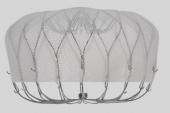FDA Warns of Air Embolism Risk With Watchman LAAO Access Systems
Boston Scientific is recommending updates to the instructions for use to minimize the issue, which has been tied to 17 deaths.

Boston Scientific is recommending updates to the instructions for use (IFU) for certain access systems for its Watchman FLX left atrial appendage occlusion (LAAO) device to help mitigate the risk of serious adverse outcomes related to air embolism during vascular and transseptal access, according to an early alert from US Food and Drug Administration.
Air is more likely to get in when the procedure is performed without positive pressure-controlled ventilation, the company says. As of July 30, there have been 120 serious injuries and 17 deaths related to the issue.
The risk of air embolism is limited solely to the implant procedure, so patients who have already received the device are unaffected by the new IFU updates, which Boston Scientific detailed in a July 30 letter.
The risk of negative left atrium pressure and air ingress is about three times higher during percutaneous procedures that involve transseptal access to the left atrium and conscious or deep sedation, the FDA notes in their alert. “This risk is especially prevalent in patients with preexisting low left atrial pressure, hypovolemia, and partial upper airway collapse.”
In this situation, failing to use positive pressure ventilation carries a risk of severe and potentially fatal outcomes related to air embolism. Outcomes tied to the specific issue with the Watchman FLX access systems have included arrhythmias, hemodynamic collapse, stroke, and other types of end-organ failure caused by ischemia.
The most common manifestation of air embolism, the Boston Scientific spokesperson said, was ST-segment elevation or visible air bubbles on imaging. Most of these events “resolved on their own or required temporary medical intervention,” although some resulted in serious harm, she added. “Based on the data included in this investigation on all Watchman cases performed between September 2024-May 2025, we estimate the rate of death resulting from air embolism to be 0.009%.”
This warning reflects how important it is to remove air zealously from all intravascular catheters. Andrew Goldsweig
The IFU updates, which also will be added to physician training for the procedure, include a warning about air embolism and additional precautions. Boston Scientific recommends being extra careful in patients under deep or conscious sedation by ensuring that they are not hypovolemic, making device exchanges “with the access system valve below the level of the heart or under fluid,” and then withdrawing devices slowly and making exchanges during expiration to reduce the likelihood of air getting in.
“This warning reflects how important it is to remove air zealously from all intravascular catheters,” Andrew Goldsweig, MD (University of Massachusetts-Baystate, Springfield), lead author of new multisociety LAAO guidelines, told TCTMD. “There is nothing Watchman- or LAAO-specific to this warning: the same issue applies to all transseptal catheterization procedures.”
Todd Neale is the Associate News Editor for TCTMD and a Senior Medical Journalist. He got his start in journalism at …
Read Full BioSources
US Food and Drug Administration. Early alert. Watchman access system issue from Boston Scientific. Published and accessed on: August 6, 2025.





Comments